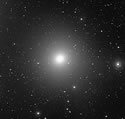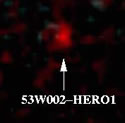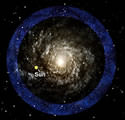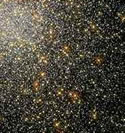
Image credit: ESO
New observations from the Japanese 8-m Subaru telescope and the ESO Very Large Telescope (VLT) have revealed new details in the Virgo galaxy cluster – located 50 million light years away. One insight is that massive young stars seem to be able to form in isolation, far away from the brighter parts of galaxies.
At a distance of some 50 million light-years, the Virgo Cluster is the nearest galaxy cluster. It is located in the zodiacal constellation of the same name (The Virgin) and is a large and dense assembly of hundreds of galaxies.
The “intracluster” space between the Virgo galaxies is permeated by hot X-ray emitting gas and, as has become clear recently, by a sparse “intracluster population of stars”.
So far, stars have been observed to form in the luminous parts of galaxies. The most massive young stars are often visible indirectly by the strong emission from surrounding cocoons of hot gas, which is heated by the intense radiation from the embedded stars. These “HII regions” (pronounced “Eitch-Two” and so named because of their content of ionized hydrogen) may be very bright and they often trace the beautiful spiral arms seen in disk galaxies like our own Milky Way.
New observations by the Japanese 8-m Subaru telescope and the ESO Very Large Telescope (VLT) have now shown that massive stars can also form in isolation, far from the luminous parts of galaxies. During a most productive co-operation between astronomers working at these two world-class telescopes, a compact HII region has been discovered at the very boundary between the outer halo of a Virgo cluster galaxy and Virgo intracluster space.
This cloud is illuminated and heated by a few hot and massive young stars. The estimated total mass of the stars in the cloud is only a few hundred times that of the Sun.
Such an object is rare at the present epoch. However, there may have been more in the past, at which time they were perhaps responsible for the formation of a fraction of the intracluster stellar population in clusters of galaxies. Massive stars in such isolated HII regions will explode as supernovae at the end of their short lives, and enrich the intracluster medium with heavy elements.
Observations of two other Virgo cluster galaxies, Messier 86 and Messier 84, indicate the presence of other isolated HII regions, thus suggesting that isolated star formation may occur more generally in galaxies. If so, this process may provide a natural explanation to the current riddle why some young stars are found high up in the halo of our own Milky Way galaxy, far from the star-forming clouds in the main plane.
The Virgo Cluster
The galaxies in the Universe are rarely isolated – they prefer company. Many are found within dense structures, referred to as galaxy clusters, cf. e.g., ESO PR Photo 16a/99.
The galaxy cluster nearest to us is seen in the direction of the zodiacal constellation Virgo (The Virgin), at a distance of approximately 50 million light-years. PR Photo 04a/03 (from the Wide Field Imager camera at the ESO La Silla Observatory) shows a small sky region near the centre of this cluster with some of the brighter cluster galaxies. PR Photo 04b/03 displays an image of a larger field (partially overlapping Photo 04a/03) in the light of ionized hydrogen – it was obtained by the Japanese 8.2-m Subaru telescope on Mauna Kea (Hawaii, USA). The field includes some of the large galaxies in this cluster, e.g., Messier 86, Messier 84 and NGC 4388. In order to show the faintest possible hydrogen emitting objects embedded in the outskirts of bright galaxies, their smooth envelopes have been “subtracted” during the image processing. This is why they look quite different in the two photos.
Clusters of galaxies are believed to have formed because of the strong gravitational pull from dark and luminous matter. The Virgo cluster is considered to be a relatively young cluster, because studies of the distribution of its member galaxies and X-ray investigations of hot cluster gas have revealed small “subclusters of galaxies” around the major galaxies Messier 87, Messier 86 and Messier 49. These subclusters are yet to merge to form a dense and smooth galaxy cluster.
The Virgo cluster is apparently cigar-shaped, with its longest dimension of about 10 million light-years near the line-of-sight direction – we see it “from the end”.
Stars in intracluster space
Galaxy clusters are dominated by dark matter. The largest fraction of the luminous (i.e. “visible”) cluster mass is made up of the hot gas that permeates all of the cluster. Recent observations of “intracluster” stars have confirmed that, in addition to the individual galaxies, the Virgo cluster also contains a so-called “diffuse stellar component”, which is located in the space between the cluster galaxies.
The first hint of this dates back to 1951 when Swiss astronomer Fritz Zwicky (1898-1974), working at the 5-m telescope at Mount Palomar in California (USA), claimed the discovery of diffuse light coming from the space between the galaxies in another large cluster of galaxies, the Coma cluster. The brightness of this intracluster light is 100 times fainter than the average night-sky brightness on the ground (mostly caused by the glow of atoms in the upper terrestrial atmosphere) and its measurement is difficult even with present technology. We now know that this intracluster glow comes from individual stars in that region.
Planetary nebulae
More recently, astronomers have undertaken a new and different approach to detect the elusive intracluster stars. They now search for Sun-like stars in their final dying phase during which they eject their outer layers into surrounding space. At the same time they unveil their small and hot stellar core which appears as a “white dwarf star”.
Such objects are known as “planetary nebulae” because some of those nearby, e.g. the “Dumbbell Nebula” (cf. ESO PR Photo 38a/98) resemble the disks of the outer solar system planets when viewed in small telescopes.
The ejected envelope is illuminated and heated by the very hot star at its centre. This nebula emits strongly in characteristic emission lines of oxygen (green; at wavelengths 495.9 and 500.7 nm) and hydrogen (red; the H-alpha line at 656.2 nm). Planetary nebulae may be distinguished from other emission nebulae by the fact that their main green oxygen line at 500.7 nm is normally about 3 to 5 times brighter than the red H-alpha line.
Search for intracluster planetary nebulae
An international team of astronomers [2] is now carrying out a very challenging research programme, aimed at finding intracluster planetary nebulae. For this, they observe the regions between cluster galaxies with specially designed, narrow-band optical filters tuned to the wavelength of the green oxygen lines.
The main goal is to study the overall properties of the diffuse stellar component in the nearby Virgo cluster. How much diffuse light comes from the intracluster space, how is it distributed within the cluster, and what is its origin?
Because the stars in this region are apparently predominantly old, the most likely explanation of their presence in this region is that they formed inside individual galaxies, which were subsequently stripped of many of their stars during close encounters with other galaxies during the initial stages of cluster formation. These “lost” stars were then dispersed into intracluster space where we now find them.
The Subaru observations
Japanese and European astronomers used the Suprime-Cam wide-field mosaic camera at the 8-m Subaru telescope (Mauna Kea, Hawaii, USA) to search for intracluster planetary nebulae in one of the densest regions of the Virgo cluster, cf. PR Photo 04b/03. They needed a telescope of this large size in order to select such objects and securely discriminate them from the thousands of foreground stars in the Milky Way and background galaxies.
In particular, by observing in two narrow-band filters sensitive to oxygen and hydrogen, respectively, the planetary nebulae visible in this field could be “separated” from distant (high-redshift) background galaxies, which do not have strong emission in both the green and red band. It is very time-consuming to observe the weak H-alpha emission and this can only be done with a big telescope.
Some 40 intracluster planetary nebulae candidates were found in this field which had the expected oxygen/H-alpha line intensity ratios of 3 – 5, such as those depicted PR Photo 04d/03. Unexpectedly, however, the data also showed a small number of star-like emission objects with oxygen/H-alpha line ratios of about 1. This is more typical of a cloud of ionized gas around young, massive stars – like the so-called HII regions in our own galaxy, the Milky Way.
However, it would be very unusual to find such star formation regions in the intracluster region, so follow-up spectroscopic observations were clearly needed for confirmation.
The VLT measurements
The only way to make sure that these unusual objects are actually powered by young stars is by a detailed spectroscopical study, analyzing the emitted light over a wide range of wavelengths. One of the objects was observed in this way in April 2002 with the FORS2 multi-mode instrument at the 8.2-m VLT YEPUN telescope at the ESO Paranal Observatory (Chile).
This was a most challenging observation, even for this very powerful facility, requiring several hours of exposure time. The brightness of the faint object (the flux of the oxygen [OIII 500.7]-line) was comparable to that of a 60-Watt light bulb at a distance of about 6.6 million km, i.e., about 17 times farther than the Moon.
The recorded (long-slit) spectrum (PR Photo 04e/03) is indeed that of an HII region, with characteristic emission lines from hydrogen, oxygen and sulphur, and with underlying blue “continuum” emission from hot, young stars. This is the first concrete evidence that some of the ionized hydrogen gas in the intracluster medium near NGC 4388 is heated by massive stars, rather than radiation from the nucleus of the galaxy.
Comparing the spectrum with simple starburst models showed that this HII region is “powered” by one or two hot and massive (O-type) stars. The best-fitting starburst model implies an estimated total mass of young stars of some 400 solar masses with an age of about 3 million years. The object is obviously very compact – it is indeed unresolved in all the images. The inferred radius of the HII region is about 11 light-years.
Young stars form far from galaxies
This compact star-forming region is located about 3.4 arcmin north and 0.9 arcmin west of the galaxy NGC 4388, corresponding to a distance of some 82,000 light-years (projected) from the main star-forming regions in this galaxy. The small cloud is moving away from us with an observed velocity of 2670 km/sec. This is considerably faster than the mean velocity of the Virgo cluster (about 1200 km/sec) but similar to that of NGC 4388 (2520 km/sec), indicating that it is probably falling through the Virgo cluster core together with NGC 4388, but it cannot have moved far during the comparatively short lifetime of its massive stars.
It is not known whether it once was or still is bound to NGC 4388, or whether it only belonged to the surroundings that fell into the Virgo cluster with this galaxy. In any case, the existence of this HII region is a clear demonstration that stars can form in the “diffuse” outskirts of galaxies, if not in intracluster space.
Because of internal dynamical processes, the stars in this object cannot remain forever in a dense cluster. Within a few hundred million years they will disperse and mix with the diffuse stellar population nearby. This isolated star formation is therefore likely to contribute to the intracluster stellar population, either directly, or after having moved away from the halo of NGC 4388.
This mode of isolated star formation does not contribute much to the total intracluster light emission – at the current rate it can explain only a small fraction of the diffuse light now observed in this region. However, it may have been more significant in the past, when protogalaxies and proto-galaxy groups, rich in neutral gas and with gas clouds at large distances from their centers, fell into the forming Virgo cluster for the first time.
Prospects
The existence of isolated compact HII regions like this one is important as a very different site of star formation than those normally seen in galaxies. The massive stars born in such isolated clouds will explode as supernovae and enrich the Virgo intracluster medium with metals.
Other possible – but not yet spectroscopically verified – compact HII regions in the halos of both Messier 86 and Messier 84 have been detected during this work. This finding thus also calls into question the current use of emission-line planetary nebulae luminosities as a distance indicator; to obtain the best possible accuracy, it will henceforth be necessary to weed out possible HII regions in the samples.
If compact HII regions exist generally in galaxies, they may possibly be the birthplaces of some of the young stars now observed in the halo of our Milky Way galaxy, high above the main plane. Observational programmes with both the Subaru and VLT telescopes are now planned to discover more of these interesting objects and to explore their properties.
Original Source: ESO News Release








